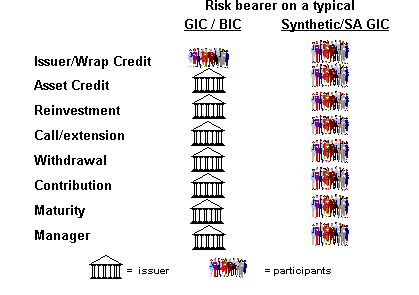Stable Value and GICs
Post on: 14 Сентябрь, 2015 No Comment

Are stable value investments registered?
Q26 How is a stable value investment purchased? Return to top
All stable value assets are private placement investments whose terms are negotiated at the time of purchase. Most typically the investor seeks bids from a number of potential issuers. Several weeks prior to the expected purchase date, the plan or its agent sends bid specifications (bid ‘specs’) to a number of providers to determine their interest in bidding upon the amount to be invested. The specifications indicate the dollar amount expected to be invested, the type(s) of contracts for which the investor would like to receive bids (window, bullet, etc.), and the desired maturity and payout provisions (one payment, installments over time, etc.) They also provide the issuer the basic data necessary to evaluate the risks of issuing a contract to that plan (See Qs 16 and 18) such as the duration and yield of the stable value fund, the size of any STIF fund within the fund, existing contract maturity schedules, the stable value withdrawal protocol (See Q 20), the types and dollar amounts of other investment options in the plan, frequency of allowed participant transfers, etc.
The issuer reviews the bid specs and determines whether or not it will bid on the deposit. For a traditional GIC, the bid is based on the current yield for investments of an appropriate duration to back the contract less deductions for asset risk charges (call and default), any liability or plan cash flow risk charges, expenses, and a return on the capital necessary to support the issuer’s guarantees. For a synthetic or separate account GIC, the bid is based upon the current earning rate of the underlying asset, with deductions for investment management fees and wrap fees (risk charges, expenses, and profit). A synthetic contract may also have custody fees (see Q17).
At the specified time and date, the investor receives the bids that have been solicited and evaluates the yields quoted relative to the risks entailed in each type of contract. Typically, the higher the credit quality and the more risks assumed by the GIC or wrap issuer, the lower the rate bid. However, because this is a private transaction, occasionally there are market imperfections which produce special value opportunities for the investor.
Q27 How does the investor evaluate and manage credit risk on stable value assets? Return to top

The first step in credit evaluation is to understand which risks are assumed by the GIC issuer or wrap provider and which are being passed through to the fund (see Q24). Where an investment contract participates in the credit risk on the underlying assets, it is important to determine what the credit guidelines and diversification policies are for the underlying assets. Where the issuer or wrap provider assumes all the asset risks, only the issuer’s credit need be evaluated.
Credit ratings from major rating agencies such as Moody’s, Standard & Poor’s, and Duff & Phelps are an excellent guide to the credit standing of investment contract issuers and any bond or mortgage investments that might be utilized in the portfolio. The table below lists various types of ratings that are most applicable. Where both asset and wrap risks must be evaluated, the listing in the bold type shows which is generally of the greater importance in determining the results to the stable value investor.
Appropriate Rating Categories for Various Stable Value Asset Types














